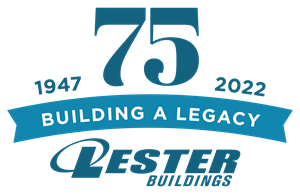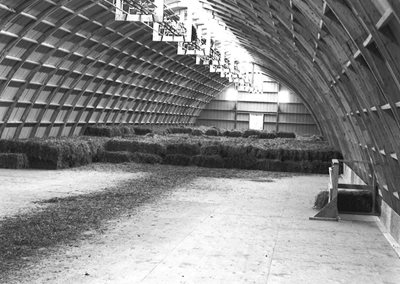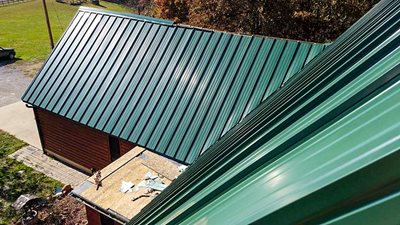For any company to not only survive, but also thrive for nearly a century, innovation has to be in its DNA. As we celebrate our 75
th anniversary here at Lester Buildings, we wanted to shine a spotlight on our company’s culture of innovation, along with some of our most notable industry-defining products and practices. So, we sat down with two of our people who constantly have innovation on their minds: President Mark Billstrom and VP of Manufacturing Tyler Bennett.
 What is your personal philosophy about innovation?
Mark:
What is your personal philosophy about innovation?
Mark: Consumers expect innovation. They’re attracted to companies that introduce change and improve their products. As the former CEO of the Walt Disney Company, Bob Iger, said, "The riskiest thing we can do is just maintain the status quo.”
Tyler: You have to innovate if you want to survive, especially in today’s market. For all the struggles we’ve encountered over the last couple of years because of the pandemic, that experience has provided loads of opportunity for us get better at what we do.
Why is innovation important when it comes to building pole barns?
Mark: Post-frame, or pole barn, manufacturing and construction is a very competitive industry, often driven by price. We like to demonstrate that all pole barns are not built equally – innovation is key to making our products better than the competition.
Tyler: Yet we’re not unlike the rest of the manufacturing world. We have more consumer demand than in the past and not that many more employees. You have to bridge that gap somehow and innovation is where it’s at. To me, that means leveraging technology to get better at what we do and using data to make better decisions.
Can you describe Lester Building’s culture of innovation?
Mark: In terms of management, we’re a very flat organization so all employees can be comfortable giving and receiving feedback, regardless of any perceived “rank.”
Also, because our buildings are custom built, our innovations often stem from customer need. For example, we created a new and different structural component this year because we had a client with a unique need. Prices for the materials that would have addressed this need were ridiculously high, so we put our engineers to work to create this structural component ourselves. We took available products, like a standard 2” x 12” piece of lumber and altered it to fulfill the customer’s need. If you’re not in our business, it might not sound too exciting, but nobody before had thought of doing what we did.
Tyler: Here’s an example of innovation on the manufacturing side: We have technology that hooks up to our manufacturing equipment that, in real time, reveals the status of all the machines in the plant. I can see what’s running to spec or what isn’t performing up to our standards. As soon as a piece of equipment needs attention, this technology sends my guys a text message and a timer starts so we can measure how quickly we get that machine performing the way it should.
Please talk about the quality of Lester employees and how that contributes to innovation.
Mark: It's sounds cliche', but our employees are honest, hard-working people. This down-to-earth attitude contributes to our culture of, “If you can make something better, why not do it?” We see this not only in the products we make, but also the internal processes that run the business. Everyone is comfortable asking, “Why do we do it this way?” and in suggesting improvements.
Tyler: We also have a network of about 170 dealers across the country – they’re the ones putting our products together every day. We’re constantly in contact with one another, and their feedback is vital to our improvement efforts. When they tell us it would be nice to have “X, Y and Z,” or, “You could make our lives better by offering this product or service,” it’s top of mind for us.
Describe some of Lester’s most important innovations over the years.
Mark: Historically, the company started innovating back in the 1950s, when it was making Quonset huts and then moved to gothic arch dome buildings.

The Uni-Frame construction method we developed decades ago, which makes all of our building components act as one structural unit, creating a much stronger, more durable building, was an industry breakthrough. Another example is the Insl-Wall
TM Panel System, which we also created years ago.
More recently, in the early 2000’s, we rolled out Power Pivot hydraulic doors, which are large top-hinged doors for buildings that house large equipment. And, among the patents we hold is one for the
Eclipse Roof System®, a through-fastened steel panel with a batten cap that hides the screws. This design gives a roof the appearance of a standing seam steel roof, but with better construction productivity and lower cost.
 Tyler
Tyler: We are also one of very few builders that construct huge dairies – some are 18 to 20 acres under one roof! We typically build one of those a year, and they require vastly different design aspects as opposed to a 40’ x 60’
hobby building.
We also have proprietary software called Improv®. At the time it came out, it was one of the first pieces of software that dealers could install on a laptop, sit in front of a customer, design their building, and come up with a quote. That may not seem innovative today, but at the time, Lester was one of the first to offer it.
Finally, just last year, we introduced
Dream Planner®, 3D software that people can use to draw their dream building in the color, size and dimensions they want. What’s more, it has an augmented reality feature built in that you can use to scan your drawing into your cell phone. Then, when you go out onto your field or property site, Dream Planner places the scan in the center of your camera so you can take a picture of it to see what it’ll look like on your land. It’s very popular with customers.
We live in such uncertain times; how do you continue to lead innovation at Lester?
Mark: It’s always top of mind. Pivoting in the last 20+ months required innovation to survive. It would have been easy to just throw in the towel and say, “We’re too busy just staying alive here. We don’t have time for forward-thinking.” But we didn’t do that. We have, and continue to make the investment of convening a monthly committee that’s dedicated to innovating products and processes.
We also continue to collaborate with our customers. For example, we recently received a call from a client who said, “We have an idea, can you help?” The concept of this project could result in the biggest building of its kind out there, and so it presents a number of structural challenges. We’ve had several conference calls internally and with the client about this idea and are in the process of developing ideas with them.
Whether you’re planning a hobby shed, equestrian arena, shouse, equipment shed, livestock containment or any other type of pole barn, if you value quality, you can trust the innovative folks at
Lester Buildings to help make your dream building a reality!
